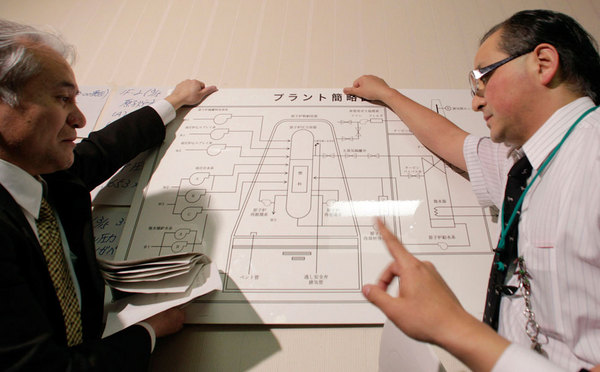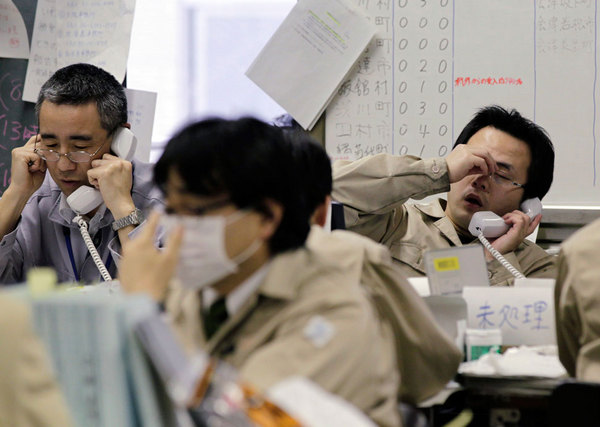
Image (Reuters): Tokyo Electric Power officials hold an illustration of a nuclear plant as they answer reporters' questions at the disaster center in Fukushima, northern Japan March 15, 2011. A fresh explosion rocked a damaged Japanese nuclear power plant on Tuesday where engineers have been pumping sea water into a reactor to prevent a catastrophic meltdown in the wake of a devastating earthquake and tsunami. Some plant workers were ordered to leave the site, a sign that the situation may be getting more serious at the complex that was damaged by a massive earthquake and tsunami.
A third explosion has struck Japan's beleaguered Fukushima nuclear power plant in as many days, after Friday's 9.0 earthquake and subsequent tsunami. This time, the plant's operator, Tokyo Electric Power Company (TEPCO) says radiation levels reached 8,217 microsieverts per hour near the plant's front gate, roughly two and a half hours after the blast.
Anyone in this kind of environment would be exposed to more than 3 years' worth of naturally occurring radiation within a single hour.
At the time of this blog post, Japan's Prime Minister is expected to address the nation on national TV shortly (NHK live stream here).
[ UPDATE, 710pm PT: Prime Minister Kan is on now, and saying that the possibility of nuclear leaks is increasing [corrected from earlier, erroneous Reuters item]. Residents within 20 km of the site are asked to evacuate ASAP; those between 20 km and 30 km are requested to stay inside.
The blast damaged an essential steel containment structure, and larger leaks of radioactive material are now believed to be immiment.
Chief Cabinet Secretary Edano followed the Prime Minister, and said a fourth reactor at the damaged nuclear plant is now on fire, with even more radiation released. Reactor No. 4 was not in operation at the time of the earthquake. The reactor contains spent fuel, not fuel rods. As was the case with the explosions at the No. 1 and No. 3 reactors, a Hydrogen explosion seems to have taken place with No. 4. Some foreign objects fell into reactor No. 4, which caused problems.
We're seeing radioactive substances being released, says Edano, and reactor No. 4 is now exposed. The blast at No. 2 reactor came 30 minutes after the incident at No. 4. A hole has been observed in the No. 2 reactor; there is a high possibility of container vessel damage for this reactor.
The monitoring levels they are dealing with are now in millisieverts, not microsieverts as previously discussed. The radiation levels being released now can impact human health, Edano says, but the danger should decrease with distance from the site. 800 plant workers were evacuated at Fukushima Plant 1. Fifty workers are still working on emergency cooling efforts. Water injection operations are continuing at reactors No. 1, 2, and 3 at Fukushima Plant 1. These operations are going smoothly, Edano says, and they beleive the cooling process is effective, but the problem is how to maintain the cooling. 'At the site right now, workers are trying to take corrective action to put out the fire. We will continue injecting seawater.'
Edano urged the public to stay calm, and go about their daily lives. He was asked whether there is a possibility of radiation danger spreading to Tokyo. He replied that 'minimal' amounts of radioactive material could spread to far locations, but the levels should not be harmful to human health. ]
[UPDATE, 8:26PM PT: Kyodo News reports that the fire at Reactor No. 4 has been extinguished.]
Earlier version of this blog post pre-press conference follows below.
Radiation is feared to have leaked after the container vessel suffered damage at the No. 2 reactor of the quake-hit Fukushima No. 1 nuclear power plant Tuesday morning, Tokyo Electric Power Co. said. The utility also admitted that a critical situation called ''meltdown'' in which fuel rods melt and are destroyed is possible at the plant where three reactor cores are believed to have partially melted following Friday's magnitude 9.0 earthquake that hit northeastern and eastern Japan.
An explosion was heard early Tuesday morning at the reactor and the radiation level temporarily shot up later, the firm said as it continued efforts to prevent overheating of exposed fuel rods.
From the updated story at
New York Times:
It was not immediately clear if the blast was caused by the buildup of hydrogen, as occurred at the two other reactors at Daiichi -- one on Saturday and the most recent one on Monday, when there was also a large explosion at the No. 3 reactor. Some early reports in the Japanese press suggested the latest explosion amounted to a different and more critical problem than the previous two.
This explosion, reported to have occurred at 6:14 a.m., happened in the 'pressure suppression room' in the cooling area of the reactor and inflicted some degree of damage on the pool of water used to cool the reactor, officials of Tokyo Electric Power said. But they did not say whether or not the incident had impacted the integrity of the steel containment structure that shields the nuclear fuel.
Related reading in today's Times: 'As Japanese nuclear power officials face the prospect of struggling for months to control several crippled reactors, a basic question arises: will there be enough workers to keep doing the job? '
Image (Reuters): Workers at the disaster response headquarters speak on telephones in Fukushima, northern Japan March 15, 2011.


No comments:
Post a Comment